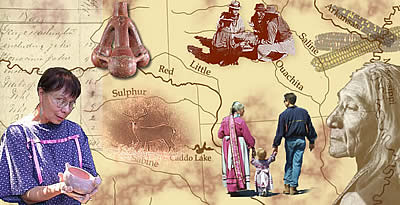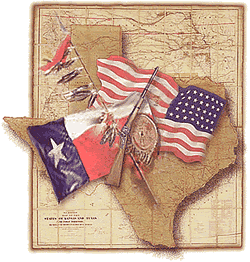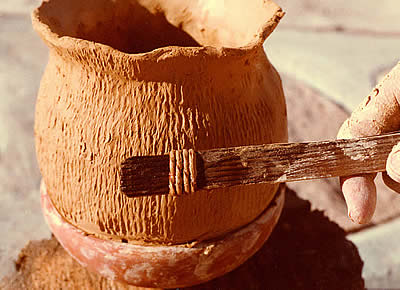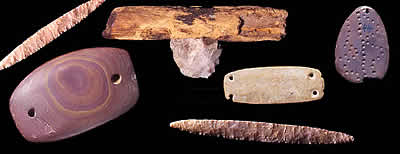Special Exhibits cover a wide variety of thematic topics. The Special Exhibits are multi-section virtual exhibits that deeply explore a particular topic. The TARL Spotlights are shorter Special Exhibits which focus on intriguing items from the Texas Archeological Research Laboratory's collections and research from the lab.
 |
Tejas: Life and Times of the Caddo Tejas: Life and Times of the Caddo theme exhibit with six interwoven exhibits providing an intimate look at the Caddo's long and distinguished history, at ancient and living Caddo tradition, and at the tribe's many contributions to the cultural heritage of Texas, Louisiana, Arkansas, and Oklahoma. The Tejas exhibits explain who the Caddo are, who they were, where they came from, and what Caddo life was like in different points in time. |
 |
Texas frontier forts are the haunting reminders of the violent cultural conflict that dominated the nineteenth century, as white settlement moved westward across the state into the domain of the Kiowas, Comanches, and other Plains Indians. Over the nearly 50-year period that the U.S. Military patrolled the Texas frontier, some 35 forts and another 20 camps and temporary outposts were constructed. Today, only a few sites with standing structures remain, while the rest are recalled only by a simple marker. In the following web "exhibits," we examine the forces and players that shaped the conflicts and the Army's solutions in four diverse regions across the state. |
 |
This exhibit explains how to make the distinctive cordmarked pottery typical of the Plains Villagers of the Texas Panhandle who lived about 550-900 years ago (A.D. 1100-1450). The use of a cord-wrapped paddle and a small stone anvil during pottery making created telltale marks that can be seen on much of the prehistoric pottery in the region. This is the first section of a series of exhibits on the theme "The Plains Villagers of the Texas Panhandle." Other related exhibits will appear by June, 2003. |
 |
Texas Indians created a great variety of stone tools and ornaments using many of the diverse rocks they found throughout the state and sometimes materials traded from distant sources. While much attention has been placed on projectile points—"arrowheads" including dart points and true arrow points—many of the other kinds of stone artifacts are not well known. This exhibit presents a photo gallery introducing many of the kinds of stone artifacts that archeologists have identified—almost everything except projectile points. |
TARL Spotlights
In the TARL Spotlight, we focus on items from the Texas Archeological Research Laboratory's collections and research from the lab. |
| Mystery Cache from the Lower Pecos Caches and burials connect us in a very personal way to past events and the traditions of ancient cultures. In 1936, archeologists from The University of Texas working in the arid Lower Pecos canyonlands of southwest Texas uncovered what they described as “a find of unusual interest”: a twined-fiber bag, filled with an array of objects, and still securely fastened after more than 4000 years. Recent studies of this TARL collection, including technical analyses of stone and bone tools and radiocarbon assays of plant remains, are helping to unlock some of its secrets. More than 80 years after its discovery, we are featuring this rare and little-known collection on TBH and rethinking its significance and meaning. |
|
 |
Geometric Morphometrics and Clovis Points Patterns in the shape and technology of stone tools can provide evidence of past human behavior, technology, movement, and the flow of goods or ideas across a landscape. Today, many anthropological research studies featuring shape analysis of materials, ranging from pottery vessels to Australopithecine and early Homo crania, use a method known as Geometric Morphometrics. Archeologist and Associate Editor of Texas Beyond History, Heather Smith, discusses the Geometric Morphometric method and her use of this approach in her research on the human occupation of the American continents at the end of the last Ice Age. |
 |
A set of Plains Indian ledger drawings continues to mystify researchers more than 50 years after its acquisition by The University of Texas. Much of what is known about the Schild Ledger Book raises questions—from the identity and tribal affiliation of the artists who created the drawings to the circumstances of the book coming into the possession of a family in Germany. Recording a way of life as it passed into history, these colorful and often complex depictions of battles, buffalo hunts, heroic deeds, and traditional customs have been variously ascribed to the Kiowa, Cheyenne, Arapaho, and Comanche. In this section, we examine questions surrounding the book and provide an online gallery of prime examples from this collection at TARL. |
| Archeomalacology: Learning from Snails A wealth of information about past environments and prehistoric human behavior can be gleaned by studying these seemingly inconsequential mollusks. TARL researcher Ken Brown leads us through the painstaking but fascinating proccesess involved in their study and explains their value as indicators of past climatic conditions and prehistoric dietary habits. |
|
 |
Microwear Analysis of Stone Tools Using a high-powered microscope and a special reference collection of replicated stone tools, TARL analyst Marilyn Schoberg studies microwear patterns on ancient tools to try to determine how they might have been used and on what materials. In some cases, tools were not used in ways we would expect, based on morphology alone, but hold a complex—and sometimes unexpected—history of use. This feature describes some of the processes involved in the analysis and some of her more interesting findings. |